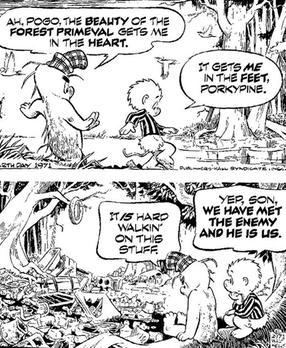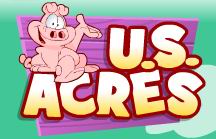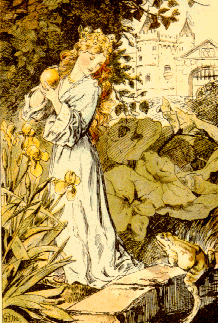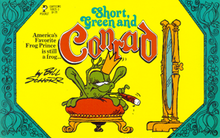
A cartoon is a type of visual art that is typically drawn, frequently animated, in an unrealistic or semi-realistic style. The specific meaning has evolved, but the modern usage usually refers to either: an image or series of images intended for satire, caricature, or humor; or a motion picture that relies on a sequence of illustrations for its animation. Someone who creates cartoons in the first sense is called a cartoonist, and in the second sense they are usually called an animator.

Arthur Floyd Gottfredson was an American cartoonist best known for his defining work on the Mickey Mouse comic strip, which he worked on from 1930 until his retirement in 1975. His contribution to Mickey Mouse comics is comparable to Carl Barks's on the Donald Duck comics. 17 years after his death, his memory was honored with the Disney Legends award in 2003 and induction into the Comic Book Hall of Fame in 2006.

Harold Rudolf Foster, FRSA was a Canadian-American comic strip artist and writer best known as the creator of the comic strip Prince Valiant. His drawing style is noted for its high level of draftsmanship and attention to detail.

Guy Berkeley "Berke" Breathed is an American cartoonist, children's book author, director, and screenwriter, known for his comic strips Bloom County, Outland, and Opus. Bloom County earned Breathed the Pulitzer Prize for Editorial Cartooning in 1987.

George Joseph Herriman III was an American cartoonist best known for the comic strip Krazy Kat (1913–1944). More influential than popular, Krazy Kat had an appreciative audience among those in the arts. Gilbert Seldes' article "The Krazy Kat Who Walks by Himself" was the earliest example of a critic from the high arts giving serious attention to a comic strip. The Comics Journal placed the strip first on its list of the greatest comics of the 20th century. Herriman's work has been a primary influence on cartoonists such as Elzie C. Segar, Will Eisner, Charles M. Schulz, Robert Crumb, Art Spiegelman, Bill Watterson, and Chris Ware.

Pogo was a daily comic strip that was created by cartoonist Walt Kelly and syndicated to American newspapers from 1948 until 1975. Set in the Okefenokee Swamp in the Southeastern United States, Pogo followed the adventures of its anthropomorphic animal characters, including the title character, an opossum. The strip was written for both children and adults, with layers of social and political satire targeted to the latter. Pogo was distributed by the Post-Hall Syndicate. The strip earned Kelly a Reuben Award in 1951.

Rupert Bear is an English children's comic strip character and franchise created by Herbert Tourtel and illustrated by his wife, the artist Mary Tourtel, first appearing in the Daily Express newspaper on 8 November 1920. Rupert's initial purpose was to win sales from the rival Daily Mail and Daily Mirror. In 1935, the stories were taken over by Alfred Bestall, who was previously an illustrator for Punch and other glossy magazines. Bestall proved to be successful in the field of children's literature and worked on Rupert stories and artwork into his nineties. More recently, various other artists and writers have continued the series. About 50 million copies have been sold worldwide.

Don Martin was an American cartoonist whose best-known work was published in Mad from 1956 to 1988. His popularity and prominence were such that the magazine promoted Martin as "Mad's Maddest Artist."

John Cullen Murphy was an American illustrator best known for his three decades of work on the Prince Valiant comic strip.

U.S. Acres is an American comic strip that ran in newspapers from 1986 to 1989, created by Jim Davis, author of the comic strip Garfield.

Barney Google and Snuffy Smith, originally Take Barney Google, for Instance, is an American comic strip created by cartoonist Billy DeBeck. Since its debut on June 17, 1919, the strip has gained a large international readership, appearing in 900 newspapers in 21 countries. The initial appeal of the strip led to its adaptation to film, animation, popular song, and television. It added several terms and phrases to the English language and inspired the 1923 hit tune "Barney Google " with lyrics by Billy Rose, as well as the 1923 record "Come On, Spark Plug!"

William Francis Messner-Loebs is an American comics artist and writer from Michigan, also known as Bill Loebs and Bill Messner-Loebs. His hyphenated surname is a combination of his and his wife Nadine's unmarried surnames.

"The Frog Prince; or, Iron Henry" is a German fairy tale collected by the Brothers Grimm and published in 1812 in Grimm's Fairy Tales. Traditionally, it is the first story in their folktale collection. The tale is classified as Aarne-Thompson type 440.

Sherrill David "Jerry" Robinson was an American comic book artist known for his work on DC Comics' Batman line of comics during the 1940s. He is best known as the co-creator of Robin and the Joker and for his work on behalf of creators' rights.
Bill Schorr is an American cartoonist of syndicated editorial cartoons and comic strips.

Krazy Kat is an American newspaper comic strip, created by cartoonist George Herriman, which ran from 1913 to 1944. It first appeared in the New York Evening Journal, whose owner, William Randolph Hearst, was a major booster for the strip throughout its run. The characters had been introduced previously in a side strip with Herriman's earlier creation, The Dingbat Family, after earlier appearances in the Herriman comic strip Baron Bean. The phrase "Krazy Kat" originated there, said by the mouse by way of describing the cat. Set in a dreamlike portrayal of Herriman's vacation home of Coconino County, Arizona, KrazyKat's mixture of offbeat surrealism, innocent playfulness and poetic, idiosyncratic language has made it a favorite of comics aficionados and art critics for more than 80 years.
Ronald Sydney Embleton was a British illustrator who gained fame as a comics artist. In the 1950s and 1960s, Embleton also pursued a career as an oil painter, and he exhibited his works widely in Britain, Germany, Australia, Canada and the USA. He was a member of the London Sketch Club and the National Society of Painters, Sculptors and Printmakers, and in 1960 was elected a member of the Royal Institute of Oil Painters.

Woodrow Gelman was a publisher, cartoonist, novelist and an artist-writer for both animation and comic books. As the publisher of Nostalgia Press, he pioneered the reprinting of vintage comic strips in quality hardcovers and trade paperbacks. As an editor and art director for two-and-a-half decades at Topps Chewing Gum, he introduced many innovations in trading cards and humor products.

Popeye the Sailor is a fictional cartoon character created by Elzie Crisler Segar. The character first appeared on January 17, 1929, in the daily King Features comic strip Thimble Theatre. The strip was in its tenth year when Popeye made his debut, but the one-eyed sailor quickly became the lead character, and Thimble Theatre became one of King Features' most popular properties during the 1930s. Following Segar's death in 1938, Thimble Theatre was continued by several writers and artists, most notably Segar's assistant Bud Sagendorf. The strip continues to appear in first-run installments on Sundays, written and drawn by R. K. Milholland. The daily strips are reprints of old Sagendorf stories.

Oaky Doaks was an American newspaper comic strip, which ran between June 17, 1935, and December 30, 1961. It was distributed by AP Newsfeatures for more than 25 years, illustrated by veteran magazine cartoonist Ralph Fuller and scripted by AP Newsfeatures comics editor William McCleery.




















